Overview
Center for Coastal Solutions Director, Associate Director, Students, Staff and Affiliates are involved in a diversity of projects focused on delivering solutions for improving the condition of coastal waterways and natural ecosystems. Our team brings expertise in biological, physical and chemical sciences as well as many fields within engineering and economics to our collaborative work. We strive for excellence in the quality of our work and our ability to collaborate in deep and meaningful ways to ensure the science and engineering we advance is used to guide real-world decisions, action, management, and policy.
Summary of Active CCS Research ProjectS
Integrating Modeling Tools and Observations for Prediction and Management of Harmful Algal Blooms in the St. Lucie Estuary and Watershed
Sponsor: U.S. Army Corps of Engineers, Principal Investigator: Mauricio Arias (mearias@usf.edu), Start date: 2023, Project size: $2.5 million
A team of 11 professional researchers and scientists from the University of South Florida (USF), University of Florida (UF), and South Florida Water Management District (SFWMD) were awarded a $2.5 million grant from the U.S. Army Corps of Engineers to support the development of new state-of-the-art water quality data and models to better predict and manage harmful algal blooms (HABs) in Lake Okeechobee and the St. Lucie and Caloosahatchee River watersheds.

Water Quality and Economic Impact Monitoring Network for Peace River Basin and Greater Charlotte Harbor Watershed
Sponsor: Florida Department of Environmental Protection, Principal Investigator: Christine Angelini (c.angelini@ufl.edu), Start date: April 20, 2022, Project size: $5.1 million
The CCS and the SAS Institute, a global leader in data analytics software, are joining forces to study the factors that influence water quality and the connections between water quality and economic activity in southwest Florida. Tapping into SAS’ comprehensive expertise in data management and analytics, CCS and SAS will develop a web-based platform to allow researchers to explore, analyze and even visualize the data collected from the water in Charlotte Harbor and gain insights into effective clean water management techniques. This project is funded by the Florida Department of Environmental Protection and features the HiPerGator, the most powerful university-owned supercomputer in the U.S. By capitalizing on the supercomputing power of the University of Florida and capabilities of SAS Viya, which is a comprehensive data management and visualization platform, the project team is in a unique position to leverage large amounts of environmental and economic data that have been collected by local, state and federal agencies as well as local partners like the Sanibel Captiva Conservation Foundation, and others to better understand how coastal water quality is changing and why.
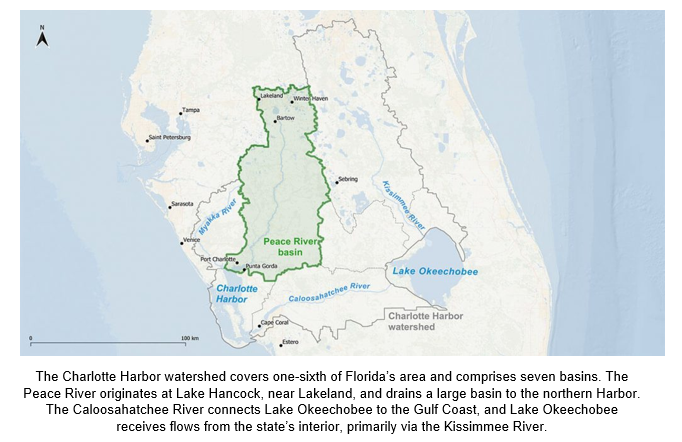
Coupling Lake, Watershed, and Estuarine Models to Better Understand the Role of Engineered Freshwater Discharges in Driving the Severity, Location, and Timing of Harmful Algal Blooms
Sponsor: U.S. Army Corps of Engineers Engineering Research and Development Center, Principal Investigator: David Kaplan (dkaplan@ufl.edu), Start Date: October 2021, Project Size: $2.3 million.
Severe freshwater and marine harmful algal blooms (HABs) in Florida’s lakes, rivers and estuaries have resulted in tremendous environmental and economic damages in recent years. In southwest Florida, blooms are becoming more frequent, more damaging, and longer lasting, threatening the health and well-being of coastal communities. The goal of this project is to develop data- and model-supported guidance for water management to prevent or reduce the impact of harmful algal blooms across the region, which responds to an increasing call for more scientifically supported water- and nutrient-management strategies, particularly for Lake Okeechobee. This project is led by CCS Associate Director Dr David Kaplan and involves Dr. Elise Morrison (UF, ESSIE), Dr. Edward Phlips (UF| IFAS), Dr Natalie Nelson (North Carolina State University), Maurcio Arias (University of South Florida) and Dr. Eric Milbrandt (Sanibel-Captiva Conservation Foundation).
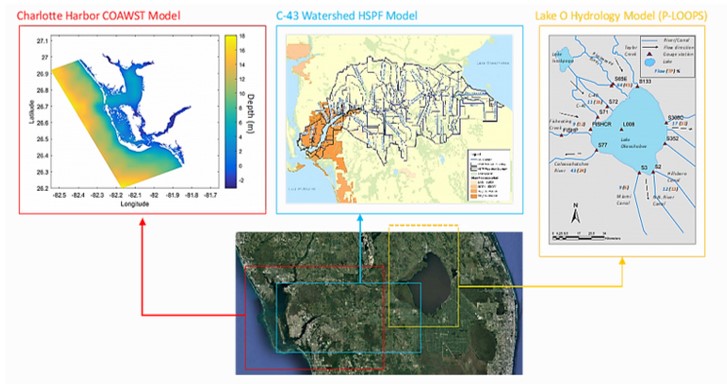
Schematic of the three hydrological models that will be integrated to investigate how water and nutrients flowing from Lake Okeechobee and the Caloosahatchee River watershed interact with tides, currents, and waves at the coast to affect coastal water quality.
Enhancing Engineering With Nature ® Design and Implementation in Coastal Systems through Multi-Sector and Interdisciplinary Collaboration
Project Sponsor: U.S. Army Corps of Engineers’ Engineering Research and Development Center, Principal Investigator: Christine Angelini (c.angelini@ufl.edu), Start Date: October 2021; Project Size: $3 million.
This project, funded by the U.S. Army Corps of Engineers Engineering With Nature initiative, is advancing understanding of how and why coastal landforms (i.e., sand dunes, beaches, mangrove forests, oyster reefs and salt marshes) are evolving. Our goal is to work side-by-side with the US Army Corps of Engineers to build and apply this knowledge to inform efforts to augment these landforms to promote their provisioning of coastal protection and other ecosystem services. A team of six PIs from the departments of Civil and Coastal Engineering (Dr. Alex Sheremet, Dr. Xiao Yu, and Dr. Maitane Olabarrieta), Environmental Engineering Sciences (Dr. Andrew Altieri, Dr. Christine Angelini), and Geological Sciences (Dr. Peter Adams) bring expertise in coastal ecology, coastal engineering, and geomorphology to this project which will focus on coastal habitats within St John’s County in northeast Florida. The project will entail deep collaboration, involving sharing of methods, analytical approaches, logistical support, and knowledge with researchers affiliated with the Network for Engineering with Nature and routine engagement with local stakeholders including the City of St Augustine, the Guana Tolomato Matanzas National Estuarine Research Reserve, the Northeast Florida Aquatic Preserve, the Florida Inland Navigation District, and the USACE Jacksonville District.
UF HWCOE News Article: The New Big Dig: UF Researchers Deliver Sustainable Solutions by Helping Government Engineers Cooperate with Nature
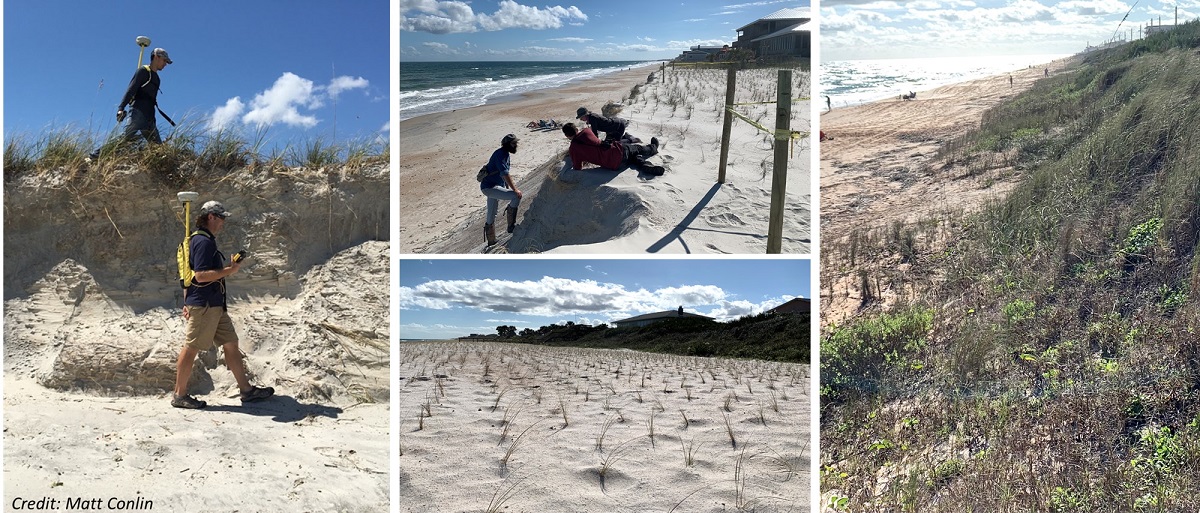
Designing Innovative Saltmarsh Restoration Approaches to Protect Public Health and Transportation Infrastructure along Florida’s Northeastern Coast
Sponsor: National Fish and Wildlife Foundation National Coastal Resilience Fund, Principal Investigator: Christine Angelini (c.angelini@ufl.edu); Start Date: March 2021; Project Size: $155,000.
The University of Florida Center for Coastal Solutions is collaborating with Wood Engineering, UF Whitney Lab, the GTM Research Reserve, City of St. Augustine, and U.S. Army Corps of Engineers’ on a National Fish and Wildlife Foundation grant. This 18-month project is assessing the potential of saltmarsh restoration techniques that reuse dredge sediment and maintain vegetation (here salt marsh cordgrass and black mangrove trees) to protect coastal community infrastructure. The project focuses on the rapidly eroding coastal wetlands surrounding the 312 Bridge in St. Augustine, Florida, a location relevant to the coastal resilience of the city’s Flagler Hospital, critical evacuation route that services the region (route 312), and a major municipal wastewater treatment facility. The project team is conducting detailed analyses of historical and contemporary rates of coastal wetland change, ecological surveys, and geochemical assessments of potential dredge sediment source and recipient wetland sites. Project collaborators from Wood Engineering will be applying this information in their production of preliminary engineering designs that augment coastal wetlands in this high priority location.
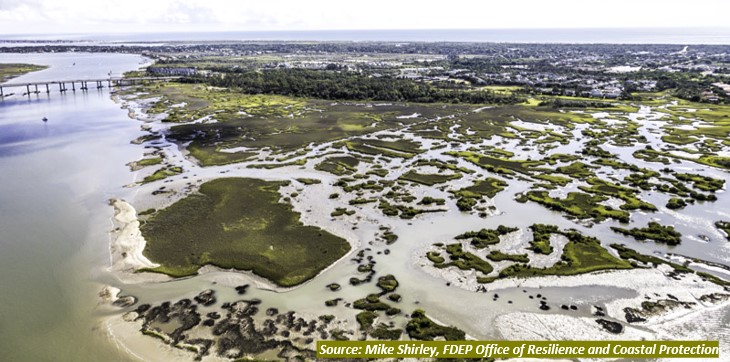
Living Shoreline Construction and Coastal Ecosystem Restoration to Enhance the Climate Resilience of Tyndall Air Force Base
Project Sponsor: REPI Challenge Program and National Fish and Wildlife Foundation National Coastal Resilience Fund; Lead Investigator; Jeff DeQuattro (The Nature Conservancy), Lead CCS Investigator: Christine Angelini (c.angelini@ufl.edu; Start Date: March 2022; Project SizeL $4.8 million ($1.2 million to the CCS).
The Nature Conservancy, in partnership with the UF Center for Coastal Solutions (PIs: Andrew Altieri, Christine Angelini, Alex Sheremet), Jacobs Engineering (John Mogge, Jason Bird, David Bell, Luce Bassetti, Matt Deavenport, and others) and The Naval Research Lab (Joe Calantoni), recently received an award from the U.S. Department of Defense Readiness and Environmental Protection Integration (REPI) Challenge Program. REPI focuses on innovative projects that enhance military installation resilience to climate change and extreme weather events. This world-class project team will use the $4.8 million grant to design and collect preliminary data for up to 1,000 feet of living shorelines and up to 3,500 feet of submerged shoreline to reduce further habitat loss via erosion and enhance storm surge protection provided to this base. Additionally, the project will create 1,500 feet of oyster reef habitat and enhance the shoreline habitat adjacent to Tyndall’s drone runway. These nature-based coastal resilience solutions will provide a vital shoreline protection service, improve water quality and overall ecosystem health, and enhance habitats vital to local endangered and threatened species, such as the southeastern beach mouse and American oystercatcher.
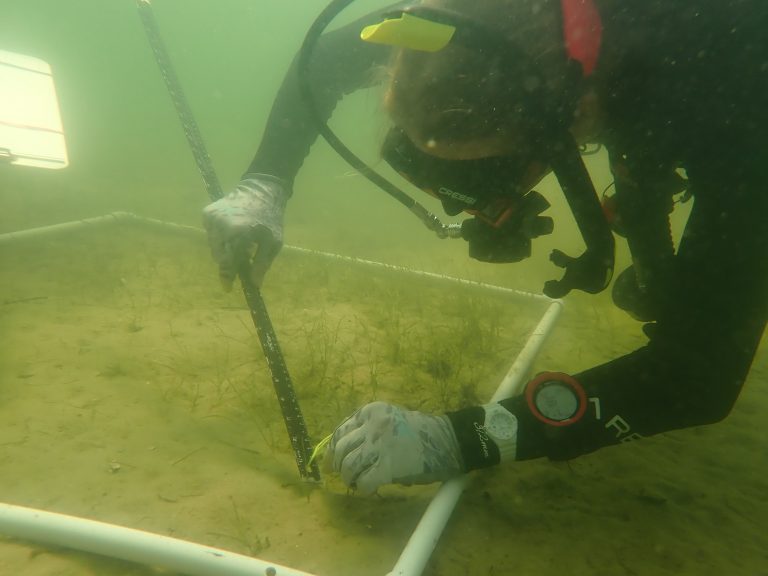
Evaluating the Potential for Predatory Shorebirds to Serve as Sentinels for Emerging Red Tide Blooms
Project Sponsor: NOAA NCCOS HAB Event Response Program, Lead PI: Christine Angelini (c.angelini@ufl.edu); Start date: March 2021; Project Size: $15,000.
NOAA’s National Centers for Coastal Ocean Science (NCCOS) provided a Harmful Algal Bloom (HAB) Event Response award of just over $15,000 to the UF Center for Coastal Solutions, Florida’s Clinic for the Rehabilitation of Wildlife (CROW; Dr. Heather Barron), the Sanibel Captiva Conservation Foundation (Dr. Eric Milbrandt), and the Florida Fish and Wildlife Conservation Commission Fish and Wildlife Research Institute (FWRI; Dr. Leanne Flewelling) to support efforts to determine if predatory seabirds experiencing brevetoxicosis – namely cormorants and royal terns – can be leveraged as early warning ‘sentinels’ for red tide events along the Florida coast. This team is testing the hypothesis that these birds consumed prey fish impacted by red tide cells located below the ocean’s surface, before the bloom could be detected by satellites or water sampling efforts. This funding supports analysis of bird and prey fish samples for brevetoxins and stable isotopes. The results, which will determine whether these species can be reliably leveraged as sentinels for soon-to-emerge blooms, will be shared with regional partners who oversee red tide water quality sampling efforts, remote sensing detection efforts (e.g. NOAA HAB monitoring and CoastWatch programs), and wildlife rehabilitation and management efforts. Findings from this work will also inform when and where subsurface and surface water sampling and detection efforts should be focused in the future.
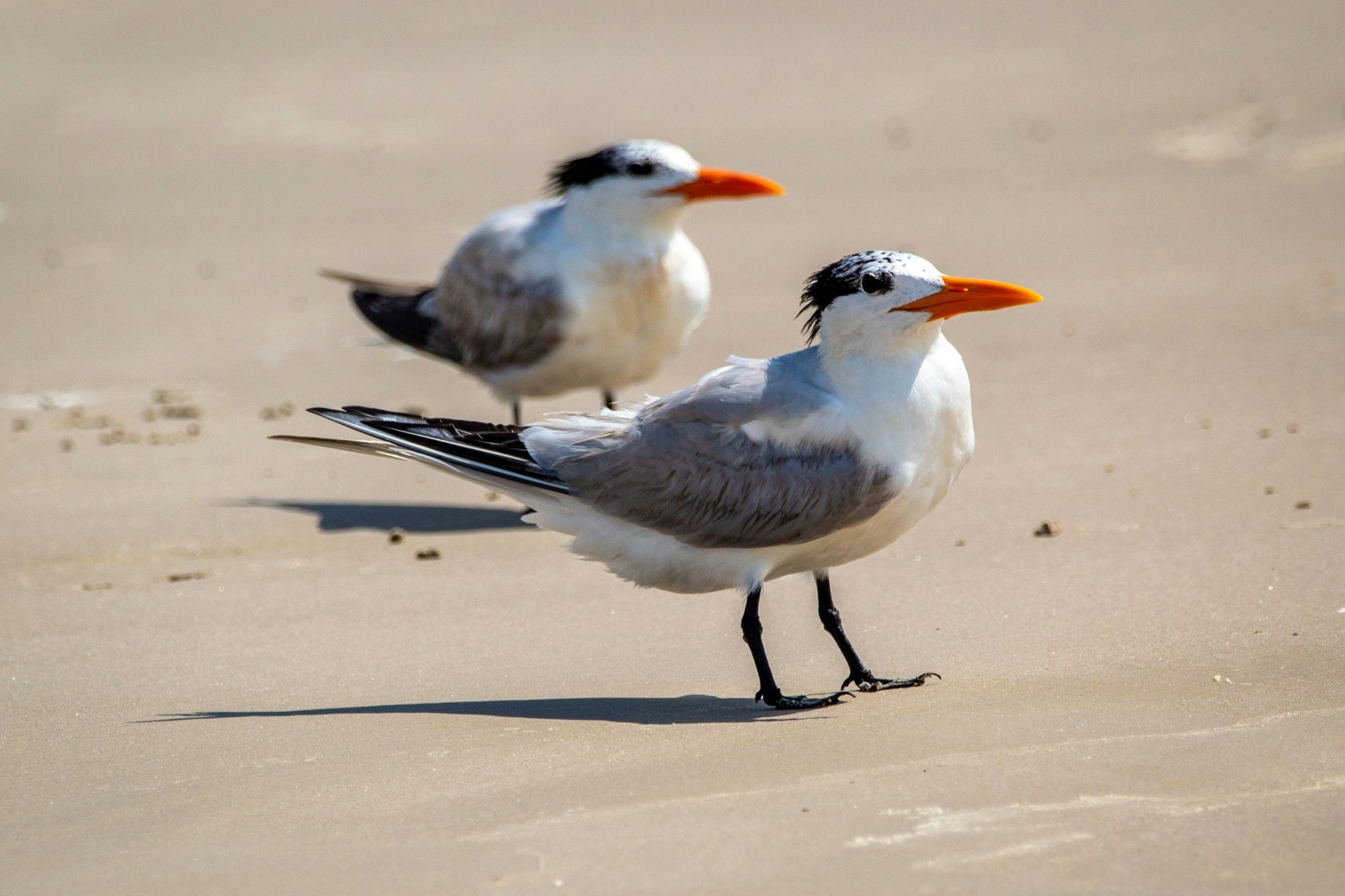
Evaluation of Ecological Response to Nearshore Nutrient Loads from the Piney Point Gypsum Stack Releases
Project Sponsor: National Science Foundation, RAPID; Lead Investigator: Elise S. Morrison, Co-PI: Edward J. Phlips; Project Size: $171,128: Start Date: March 2021
Project Sponsor: The Ocean Conservancy, Lead Investigators: Elise Morrison, Andrew Altieri, Ed Phlips; Project Size: $24,000.
From late March to early April 2021, 215 million gallons of phosphogypsum waste was released into Tampa Bay, Florida. During that time, an estimated 205 tons of nitrogen was input into the system. In response to this event, members of the CCS collaborated with the Tampa Bay Estuary Program (TBEP) and other local partners to identify key monitoring sites that would enhance monitoring efforts and augment existing TBEP seagrass monitoring stations. Bi-weekly sampling is ongoing at these monitoring sites, to evaluate changes in water quality, phytoplankton communities, particulate organic matter, seagrass and macroalgae abundance and tissue composition. Stable isotope “fingerprinting” has also been undertaken to evaluate the fate of the discharge and its influence on primary producers (phytoplankton, macroalgae, seagrasses) in the region. This work complements seagrass monitoring efforts that have been ongoing since the 1990s, and builds on phytoplankton community studies that have been conducted by team member, Dr. Ed Phlips in coastal waters across the state of Florida.
